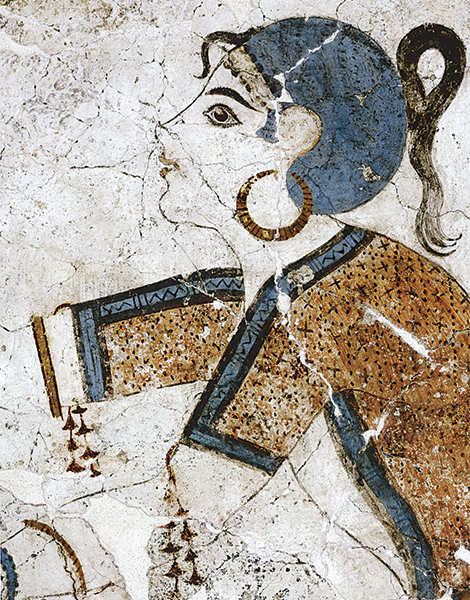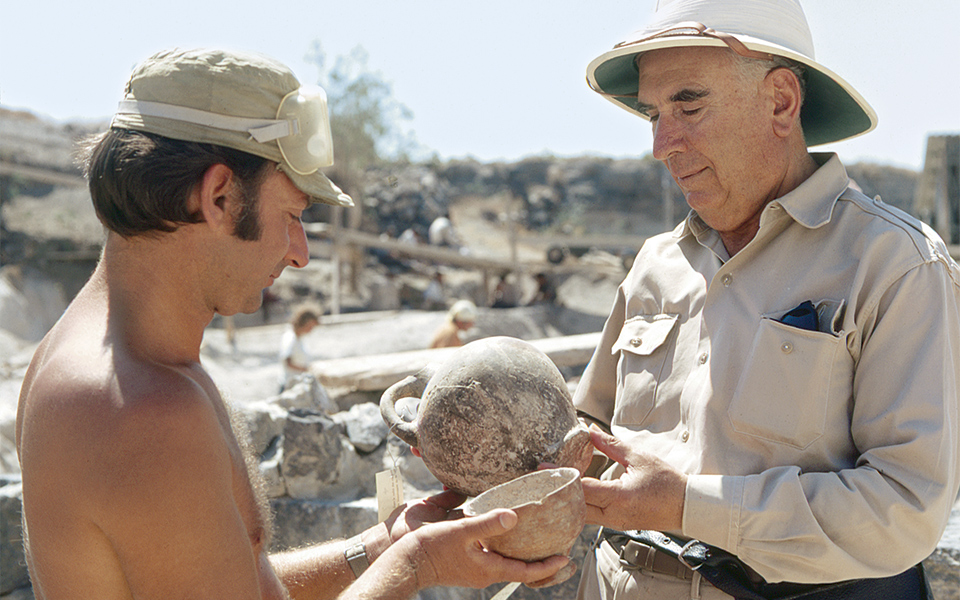February, 1961. A young archaeologist arrives by sea in Santorini, after a 48-hour sail from Mykonos! He has changed boats twice, overnighted in Syros and Ios, and now catches his first glimpse of the caldera at dawn. “Anyone who hasn’t visited Santorini by boat at least once, entered that giant crater and sensed the awe that it provokes, is missing out,” says Christos Doumas, an emeritus professor of prehistoric archaeology.
Back then, he was 28 years old and a junior archaeologist in the Cyclades. His mission was to evaluate a group of graves (early Christian, as it turned out) that had been revealed during building work to enlarge the high school of Thera – as the island is officially called.
Santorini in those days bore no relation to the glamorous image it presents today. “Everywhere there was evidence of the great earthquake of 1956. Oia was a tiny village, almost in ruins. At Fira, there was only Nikolas’ taverna. That is where all of us, the workers who weren’t locals, went to eat. Most of the island’s inhabitants were farmers or herders –there were very few craftsmen – and given that they only produced grapes and tomatoes, they had to import a lot of their produce.” That year, Doumas spent only a few weeks in Santorini. But he would come back, and stay for good

© ''Prehistoric Thera'' by Christos Doumas, published by the John S. Latsis public benefit foundation
Today, 2017. A few months ago, Christos Doumas was made an honorary citizen of Thera. It was to be expected. His occupation with the island’s ancient heritage now goes back more than 50 years. “As a student of the ancient civilizations of the Aegean, I have become accustomed to measuring time in millennia. Half a century is like an instant,” the professor and director of the Akrotiri excavations says, laughing. “However, taking stock of what I have achieved in that half century makes me feel rich. Once, a high school student from Emporio asked me what I had gained from working in Santorini all these years. I replied that ‘the wealth that I acquired here is priceless. And it is of such a kind that I am not afraid of losing it or having it stolen.’”
In the autumn of 1968, Doumas returned to Athens from England, where he had received his doctorate. “I presented myself to Spyridon Marinatos, the general director of the Archaeological Service, who one year earlier had begun to excavate Akrotiri. He asked me where I would like to serve. I replied that I would prefer to return to the Cyclades. ‘I need someone to work with me at Akrotiri,’ he told me. That is how I found myself back in Santorini. I was lucky. By working next to Marinatos, I learned a lot.”
From that point on, Doumas never left. He now feels like a Santorinian. “I feel like an Akrotirian! If I go a month without visiting the excavation, I get withdrawal symptoms…”
Pride in Akrotiri

© ''Prehistoric Thera'' by Christos Doumas, published by the John S. Latsis public benefit foundation
In 1974, Marinatos passed away and the following year Doumas himself took over running the excavation, bringing to light an amazing wealth of finds and information. He continues to work tirelessly at the age of 83. “We should be proud of Akrotiri. It is on the curriculum in every university in the world where archaeology is taught. In the long-term history of Aegean civilization, it is considered on a par with the Acropolis and Mt Athos. It is an incredibly significant heritage, which it is our duty to present to the world, and not to abuse,” he says.
Listening to him talk about prehistoric Thera is a joy. He talks about its inhabitants who, having covered their basic needs, graduated to pleasure, developing gastronomy. He speaks, too, of the flowering of art as way of projecting social status and about a society with a democratic structure. “It is not accidental that men, women and children are all depicted to an equal degree in the frescoes.
This is why Akrotiri is known as the ‘prehistoric Venice of the Aegean,’” he explains, referring the Italian republic’s reputation for egalitarianism. Even hearing him talk about the volcanic eruption, the largest on the planet in the last 10,000 years, that totally destroyed Santorini and the nearby islands, is fascinating. “If it weren’t for the volcano, we wouldn’t have Santorini as we know it today, and of course there would be no Akrotiri. The volcanic ash ‘saved’ the remains of the prehistoric town from the passage of time,” he stresses.

© ''Prehistoric Thera'' by Christos Doumas, published by the John S. Latsis public benefit foundation

© ''Prehistoric Thera'' by Christos Doumas, published by the John S. Latsis public benefit foundation
What has he learned from archaeology? “That the history of humanity can’t be shoehorned into the little boxes that we archaeologists have created, such as ‘from x date to y.’ It is a continuum, and if you can’t understand that, you won’t understand anything. Every civilization is nothing but the sum of the responses of humans to the environment. We have a variety of environments on this planet, and therefore a variety of civilizations.”
And what has this excavation still got to contribute, 50 years on? “Within the covered area, we’ve identified 35 buildings. Of these, only four have been excavated, and we’ve recovered over 14,000 whole pots from them! You can appreciate that we still have many centuries of work under this protective roof!”
Santorini of Yesteryear
Doumas’ stories bring us back to a time when even a telephone call was a complicated undertaking. “From the excavation site, we had to walk to Mrs Kalliope’s house; she had the only telephone in the area. She connected us to Pyrgos, they connected us to Fira and then the call would go through to Athens. The whole thing took about an hour.” Doumas wasn’t always at the site. “From 1968, when I settled permanently, I spent all week at Akrotiri and on weekends I explored the ‘other’ Santorini: the trails, the villages, the Byzantine and post-Byzantine monuments. I wanted to understand how this society evolved. For example, in Fira at the time, there were around 15 carpenters, for a population of fewer than 400. Why, I wondered, did they need so many?
I soon learned that they crafted the barrels for the wine that was exported. The ships that left mainly for Odessa (which had a large Greek community) full of barrels of wine couldn’t return empty; it wasn’t economical. So they filled their holds with wheat and stacked their decks with tree trunks for the Santorinians to build new barrels for the next round of exports. These are the kind of fascinating things I learned.”

© Vangelis Zavos
In Santorini, Doumas learned about more than the place and its people; a mainlander, he got to understand the behavior, culture and character of islanders. “Santorinians, even if they didn’t all travel, heard stories from the sailors, and had open horizons, as all islanders do. They developed a respect for ‘the other,’ an understanding that, all over the world, people face more or less the same problems. And another thing: for the islander, the sea is a road that can open up new horizons, but if you don’t develop initiatives, if you don’t improvise when required, the almost perpetually stormy sea can ‘eat you alive.’
This uncertainty accounts for the fact that we Greeks find it hard to plan ahead. For the Aegean islander, it’s the end goal that matters, not the time required to accomplish it.” Recently, Prof. Doumas authored a book titled “Prehistoric Thera,” which is published by the John S. Latsis Public Benefit Foundation and distributed for free to research institutions such as museums and university libraries. What did he want to convey to the reader? “An understanding that ‘sic transit gloria mundi’ or ‘thus passes the glory of this world.’”
Is he concerned about his own legacy? “Honestly, no. I’ve done good things and bad things. Some will remember the former, others the latter. It’s my reputation now that concerns me, not after I’m gone. I don’t believe in the next world. I’m not afraid of becoming a cloud…”












